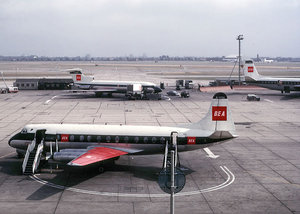Vickers Viscount
|
|
The Viscount was a medium-range turboprop airliner introduced in 1953 by Vickers-Armstrongs, making it the first such aircraft to enter service in the world. It would go on to be one of the most successful of the first-generation post-war transports, with 445 being built over the life of the production line. It was particularly well liked by the passengers, as it was quiet, vibration free, and had much larger windows than those found on more modern airliners.
| Contents |
History
The original design resulted from the Brabazon Committee's Type IIB design, calling for a smaller medium-range turboprop-powered pressurized aircraft to fly its less-travelled routes, carrying 24 passengers up to 1,750 miles (2,816 km) at 200 mile/h (322 km/h). British European Airways (BEA) was involved in the design and asked that the plane carry 32 passengers instead, but remained otherwise similar. The Type IIA was to be a piston powered version of similar performance, and was built as the Airspeed Ambassador.
The resulting Vickers Type 630 design was completed at Brooklands by Chief Designer Rex Pierson and his staff in 1945, a thirty-two seat airliner powered by four Rolls-Royce Dart engines for an improved cruising speed of 275 mph (443 km/h). An order for two prototypes was placed in March 1946, and construction started almost immediately. Originally to be named Viceroy, the name had to be changed after the partition of India in 1947. There was some work on replacing the Darts with the Armstrong Siddeley Mamba, but this was dropped by the time the prototypes were reaching completion.
The prototype Model 630 flew on July 16, 1948, and the second prototype was built as a test-bed with two Rolls-Royce Tay turbojets in place of the four Darts. The first prototype was awarded a restricted Certificate of Airworthiness on September 15 1949, followed by a full Certificate on July 27 1950, and placed into service with BEA the next day to familiarize the pilots and ground crew with the new aircraft. However the design was considered to small and slow at 275 mph (443 km/h), making the per-passenger operating costs too high for regular service.
The design then went back to the drawing board and re-emerged as the larger Type 700 with up to forty-eight passengers (53 in some configurations), and a cruising speed of 308 mph (496 km/h). The new prototype first flew August 28, 1950. British European Airways ordered twenty V.701s, and soon orders came in from other airlines as well. The first 700 was delivered to BEA in January 1953, and in April began the world's first turboprop-powered service.
Three years later the Viscount won all honours in the transport section of the 12,367 mile (19,903 km) air race from London to Christchurch, New Zealand. The aircraft averaged 320 mph (515 km/h) in the event, crossing the finishing line nine hours ahead of its closest rival. The Model 700D added more powerful engines, and the Model 724 included a new fuel system, two-pilot cockpit, and increased weights.
The final major change to the design was the Type 800 Super Viscount, stretched 3 ft 10 in (1.2 m) for up to 71 passengers. A further change to the fuselage was planned, but later renamed as the Vanguard instead.
The type continued in BEA and British Airways service until the 1980s, eventually being passed on to charter operators such as British Air ferries (later British World). The last British-owned Viscounts were sold in South Africa where a small number are still in use.
Variants
- 700 - the first production version, 1,381 hp (1,030 kW) engines, 287 built
- 700D - 1,576 hp (1,175 kW) engines
- 724 - 15 sold to Trans Canada Airlines (TCA) of Canada, included more electrical power, a new fuel system, and cold weather operation provisions.
- 745 - 40 sold to Capital Airlines of the USA
- 757 - 35 for Trans Canada Airlines with more powerful 1,600 hp (1,193 kW) Dart 510 engines
- 771D - improved 770D
- 800 - fuselage stretched 3 ft 10 in (1.2 m), 67 built
- 810 - 1,991 hp (1,485 kW) engines, 84 built
Specifications (Model 800)
General Characteristics
- Crew: two
- Capacity: 75 passengers
- Length: 85 ft 8 in (26.11 m)
- Wingspan: 93 ft 8 in (28.56 m)
- Height: 26 ft 9 in (8.15 m)
- Wing area: ft² ( m²)
- Empty: 41,479 lb (18,854 kg)
- Loaded: lb ( kg)
- Maximum takeoff: 72,281 lb (32,855 kg)
- Powerplant: 4x Rolls-Royce Dart RDa.7/1 Mk 525 turboprops, 2,100 shp (1,566 kW) each
Performance
- Maximum speed: 352 mph (563 km/h)
- Range: 1,735 miles (2,776 km)
- Service ceiling: ft ( m)
- Rate of climb: ft/min ( m/min)
- Wing loading: lb/ft² ( kg/m²)
- Power/Mass: hp/lb ( kW/kg)
Related content
Related development:
Comparable aircraft: L-188 Electra - Ilyushin Il-18
Designation sequence:
|
Lists of Aircraft | Aircraft manufacturers | Aircraft engines | Aircraft engine manufacturers Airports | Airlines | Air forces | Aircraft weapons | Missiles | Timeline of aviation |


